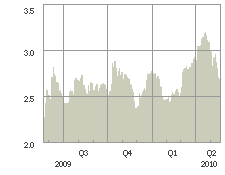The June 3-month banker’s acceptance futures are trading at 0.89% at present.
This suggests that the short-term interest rates (the target overnight rate) will likely raise 0.5% to 0.75%. However, the banker’s acceptances generally are a quarter point over the prevailing target rate, which suggests the market is pricing an approximate 40% chance that the Bank of Canada will only raise 0.25%.
One month T-bills are at 0.23%, 3-month T-Bills are at 0.47%.
My justification for a 0.5% raise is simple – they want to make a statement.
I rarely have strong feelings about currency trading, but my guess is that the Canadian dollar will spike briefly on the announcement and then will go through a decline.
Most of the media thinks that the Bank of Canada rate increases will result in currency appreciation, but they will get the opposite results – low interest rates causes a lot of currency holding through carry trading. Since traders are on the margin side, a higher rate will result in currency outflows. It is likely the US dollar will be the one to rise relative to the Canadian dollar, so I’d get your cross-border shopping in sooner than later. You can also do “cross-border shopping” by buying US equities. The markets suggest that the US federal reserve will start raising rates around the beginning of 2011.
